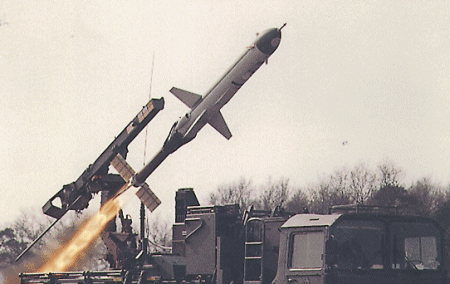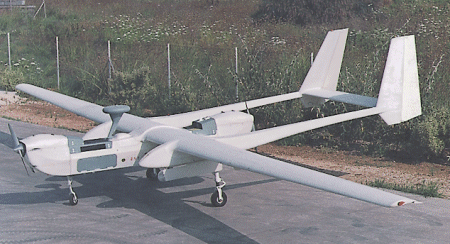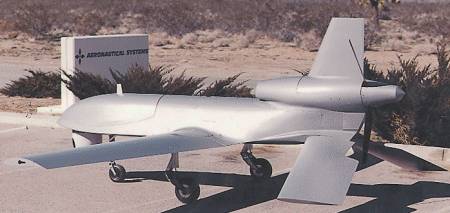Ramon Lopez/BRISTOL

With some unmanned air vehicles (UAVs) - including the Bombardier CL-289, IAI/TRW Hunter, General Atomics RQ-1A Predator (above) and IAI/AAI Pioneer - being put through their paces over Yugoslavia, gathering intelligence in what may prove to be the longest combat use of UAVs to date, this year's Paris air show will be more than just a showcase for the increasingly ubiquitous UAV.
Rather, it will be a testimony to the coming of age of the UAV for military and civilian use.
At a recent international conference, held at the UK's University of Bristol, both the CL-289 and the Predator (with a new commercial variant ready to fly) were high on the agenda. So too was consideration of compact synthetic aperture radars (SAR) for tactical UAVs. Meanwhile, military applications could expand as Predator is tested with the US Air Force's Northrop Grumman E-8C Joint Surveillance Target Attack Radar System (Joint STARS), and Hunter is teamed with the Boeing AH-64D Apache Longbow attack helicopter.
Participants at the meeting were also briefed on advances in heavy fuel engines (HFE) that could soon replace gasoline-burning models. At the same time, bird-sized Micro Air Vehicles (MAV) now fly both inside and out of the USA.

The German army was an early proponent of UAVs, having fielded, in the early 1970s, the Bombardier CL-89 , which it replaced with the CL-289 (above) in 1991. As seen in the Kosovo campaign, the main tasks for UAVs are and will be reconnaissance, intelligence, surveillance, and target acquisition, but the German army has implemented varied programmes for developing and fielding future reconnaissance, support and combat UAVs through to 2010.
Brevel, LUNA and Camcopter
They include the short-range (50km) TA KZO/Brevel and the close-range (20km) LUNA. The latter, built with off-the-shelf components, was tested last year. The multi-spectral sensor Airborne Minefield Reconnaissance UAV for stand-off detection, the compact rotary-wing Schiebel Camcopter, will undergo field trials this year with procurement expected in 2005. The Camcopter is powered by a two-stroke gasoline engine. Its autonomous flight controls are based on inertial navigation, combined with differential global positioning system (GPS) satellite navigation.
Upgrades to the CL-289, including a synthetic aperture radar/moving target indication (SAR/MTI), greater endurance and interoperable ground station are planned. The truck-launched reconnaissance UAV is also undergoing a navigation system upgrade with GPS being added, plus improved hardware and software for the onboard control computer.
Joint procurement of an endurance UAV is planned for 2005, based on the success of long-distance datalink and platform experiments that have been ongoing since 1998. Production is expected to begin a year later on the STN Atlas Elektronik Taifun combat UAV which will attack ground targets on the battlefield, such as tank columns, artillery positions, missile sites and parked aircraft, flying autonomously or under ground operator control. Still in full-scale development, the cross-wing pusher propeller-equipped Taifun, which uses a DaimlerChrysler Aerospace (Dasa) millimetre wave radar, is intended to loiter for up to 4h at a range of up to 200km. A Taifun system is to consist of 72 air vehicles and a ground control unit.
The STN Atlas Elektronik Mucke electronic countermeasures UAV is expected to be operational in 2005. Based on the KZO UAV system, both UAVs are designed to operate jointly. The definition phase of the Mucke project, which includes flight trials, runs until the end of 1999, when engineering development will begin and continue for three years.
Dasa's SEAMOS rotary-wing naval UAV is a key element of NATO Project Group 35's trilateral international technology demonstrator project. It has been upgraded with extended range flight guidance software, a hybrid navigation system from Honeywell and an Allison 250 C20 engine. Flight testing of the UAV, which is destined for use on the German navy's new K130 corvette in 2005, will begin in September.

The Belgian Government, which selected the IAI Hunter to replace the army's Epervier UAV, used for battlefield surveillance, is in preliminary talks with the US DoD to buy the Raytheon Tactical Control Station. TheB-Hunter will be built in Belgium as part of the $71 million contract won over bids from France's SAGEM and Thomson. The order is for three systems, each with six aircraft. Initial deliveries are set for August next year.
Early this year, the US Air Force's UAV Battlelab, at Eglin AFB, Florida, sponsored a demonstration to fuse radar and imagery target information on board a Joint STARS aircraft to better identify targets being tracked by the Northrop Grumman E-8C airborne ground surveillance system. The flight test, involving Predator at Nellis AFB, Nevada, was deemed a success.
Meanwhile, under a $1.2 million contract with the Boeing Phantom Works, the US Army is equipping a Hunter and two AH-64D Apache Longbows with command, control and communications equipment to allow control from the helicopters. The Airborne Manned/Unmanned System Technology Demonstration will culminate in 2003 with field trials to see whether Hunter can spot ground targets for the gunships.
Work is ongoing to develop a small synthetic aperture radar/moving target indication payload for the US Army's future Tactical UAV (TUAV) based on the Northrop Grumman Tactical Endurance Synthetic Aperture Radar, which is Predator's adverse weather sensor. The company is working under a $7.3 million US Army contract that could reach a total value of $12.4 million for the three-year development programme. The TUAV payload will weigh 31kg (68lb), 45kg less than its predecessor. Northrop Grumman will deliver two units for flight tests beginning in 2000. Contract options allow for fabrication of five more sensors.
General Atomics and Sandia National Laboratories, meanwhile, have co-developed the LYNX synthetic aperture radar and test flown it on the I-Gnat drone. The 52kg SAR will be soon be ready for production. A lighter version is being developed for the Prowler II TUAV (below).

Fiercer predator
Using internal funds, General Atomics is developing the more capable Predator B drone which will fly for the first time early next year. The Predator B will be powered by an AlliedSignal TPE331 turboprop engine, which burns jet fuel. The firm hopes to interest the USAF in the improved drone. Predator B could also be used for telecommunications relay and provide a broad band tactical communications alternative to satellites.
US military interest in MAVs is well established, but the German Army plans to conduct its own experiments in 2000. Using company funds, Dasa is test flying 30cm-wingspan MAV prototypes designed for military applications. Powered by lithium batteries, its video camera payload weighs only 8g. The firm hopes to soon be on contract with the government for "a special German army programme".
The US Navy is developing an autonomous, electric-powered MAV to suppress enemy air defences. As envisioned, a swarm of the bird-sized drones would be launched to knock out radar-guided surface-to-air missile batteries. Dubbed the Micro Tactical Expendable, it will have a wingspan of 15-20cm. With a 15g payload, it would fly for at least 20min.
The radar jammer, with a mass (including batteries) of less than 15g, is in development. Object recognition will provide terminal homing, and a collision avoidance sensor is being developed, based on optical flow techniques similar to those used by insects. The USN plans to award a motor development contract later this year for development of a 6g electric motor. The MAV is to be demonstrated in 2002.
Development of heavy fuel-burning engines for TUAVs is ongoing by the UK's UAV Engines (UEL), Germany's Wankel Rotary and the USA's General Atomics. UEL has worked over the past decade to adapt its line of 22kW (30hp) to 75kW gasoline-fed engines to burn various jet fuels, and it has been able to convert the AR-801R engine to burn jet fuel because of recent availability of refined electronic fuel injection components. The engine has run only 10h and durability runs are required.
General Atomics seeks USAF support for a Predator HFE in-house development that is ready to undergo flight testing. The company's HFE for Prowler II, which will fly in the next two months, is developed from a marine powerplant. The Wankel Rotary heavy-fuel VLDE 407 SDT engine should achieve 32kW. A more powerful (67kW) turbocharged twin-rotor version would follow, and a third model for manned aircraft applications is in development.
Source: Flight International























